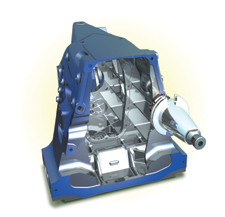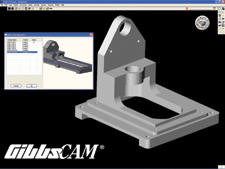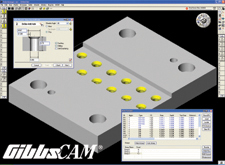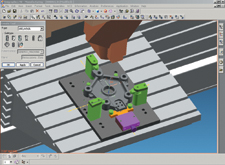June 1, 2004
By Louise Elliott
The days of CAM operators having to work with dumb 3D solid models by printingout 2D flat drawings to obtain tolerances and dimensions are finally coming toan end. Such information is generally called nonnominal or GDandT (geometricdata and tolerances). Although nonnominal data hasn’t yet been associated withthe solid models in a machine-readable manner—except for MCAD-to-CAM communicationsin integrated products from the large MCAD/CAM developers—some tools enablingsuch association now exist and are being tested. And some MCAD companies havemade it much easier for CAM programs to access the data, even if not yet in anautomated manner.
Below left: UGS’s PLM XML, upon which the company’s NX products are based, willeventually enable third-party applications to share the same level of MCAD-to-CAMassociativity that currently exists within the NX suite.
 The Industry Is Starting to Wake Up
The Industry Is Starting to Wake Up Most CAM programs create toolpaths for many different kinds of machining—prismaticand complex parts, for which exact tolerances are essential, and mold and dieapplications, where surface smoothness tends to be of greatest interest. For thepast few years, John Callen, vice president of technical marketing for Gibbs andAssociates, has been the most outspoken proponent of MCAD companies making nonnominaldata available in a computer-readable form. And he now sees bright light at theend of the tunnel. “The ]MCAD] industry is starting to wake up to the value ofnonnominal data associated directly with the solid model,” Callen says.
For example, the three major MCAD/CAM developers—UGS, Dassault Systemes, andPTC—all have the capability internally. They, and most other MCAD developers,are currently studying and testing the newly introduced ISO standard, STEP AP203 Second Edition, as well as a similar standard from the ASME, Y1441, both ofwhich contain GDandT data associated with the solid model. SolidWorks providesAPI (application programming interface) tools to access nonnominal data, and Autodeskis working on encoding nonnominal data in its drafting subsystem, according toCallen.
“UGS wants to make the full model data available to third parties,” Callen says,“and they provide so many ways to do so that it can get confusing.” One way isvia the Parasolid modeling kernel, “But the nonnominal data itself exists outsideof Parasolid,” he explains.
Another way to get nonnominal data is via the production and manufacturing (PMI)format of JT. However, this is still only a visualization file with the data annotated.Vynce Paradise, a director for NX Machining at UGS, says that a team is workingon making the nonnominal data computer-available via
Below, left: GibbsCAM’s ability to read native SolidWorks part and assembly filesincludes being able to access various configurations in the file.
Below, right: GibbsCAM’s ability to read native SolidWorks part and assemblyfiles includes being able to access various configurations in the file.
 Callen says that other MCAD companies are also working on this, but are undernondisclosure agreements. From the viewpoint of GibbsCAM, he says, “We supportindustry standard formats, license the commercial kernels, and use a reverse engineeringsolution to work with native CATIA files. Customers want us to be able to dealwith whatever native ]MCAD] files they use, and ]MCAD] vendor facilitation ofthis objective is undergoing transition.” Specifically, he says, the Parasolidand ACIS modeling kernels can be licensed to act as lightweight data servers makingdata associated with the solid model available.
Callen says that other MCAD companies are also working on this, but are undernondisclosure agreements. From the viewpoint of GibbsCAM, he says, “We supportindustry standard formats, license the commercial kernels, and use a reverse engineeringsolution to work with native CATIA files. Customers want us to be able to dealwith whatever native ]MCAD] files they use, and ]MCAD] vendor facilitation ofthis objective is undergoing transition.” Specifically, he says, the Parasolidand ACIS modeling kernels can be licensed to act as lightweight data servers makingdata associated with the solid model available.PTC does not offer this capability with its Granite modeling kernel, says FrancoisLamy, director of Product Management, Production Applications, for PTC, primarilybecause so far no third-party application developers have built their applicationson Granite.
Below, left: Holes identified in the part, in this case through GibbsCAM’s automatedfeature-recognition capabilities, are loaded into the Hole Manager for automaticprogramming by the Hole Wizard.

Interoperability and the New Standards
MCAD interoperability issues tie into the CAM connectivity initiatives. Asa Trainer,PTC’s director of Product Management focusing on interoperability, says that anumber of CAD groups are currently testing the shifting of syntax from STEP AP203 to AP 203 Second Edition, which incorporates nonnominal content, althoughthe tests are not specific to nonnominal data. “Overall, there’s a shift awayfrom boundary representation as a transfer tool,” Trainer says. “Everyone is lookingat CHAPS ]construction history and parametric shapes] and GDandT, which is intwo STEP formats—AP 203 Second Edition and AP 214. The latter is being drivenprincipally in Germany by the Pro-STEP community there. AP 203 Second Editionharmonizes with AP 214’s capabilities, but is more flexible and has additionalcontent.”
Trainer believes that, in time, it will be possible for vendors to get a usefulmechanism for transferring enriched information around the CAD model for CAM dimensions,quantities, and tolerances. He cautions, however, that while this informationcould be interpreted directly by machine, it will be hard for the vendor to validate.“Vendors are hoping that a set of recommended practices will let content and presentationof content be embedded in the solid model.”
Right: Pro/E Wildfire 2.0’s new Annotation Features allow traditional 2D drawinginformation to be captured and managed in the 3D models. This enables clearercommunication of information like dimensions, tolerances, surface finishes, GDandT,and other critical design information.
Dassault Systemes has not heard of any frustration from CAM-side users, saysMichael Stevens, CATIA NC specialist with IBM PLM. It uses “knowledge-based programmingthat applies rules for programming for manufacturing,” he says. “This looks attolerances assigned to features in the specific part, and also provides ways tocheck for manufacturability during the design process.”
The availability of nonnominal data to CAM varies from MCAD program to MCAD program,says Gary Hargreaves, director of Business Development for Mastercam. “Customerswant to see dimensions come across from CAD to CAM, and while this can be donewith standard translators, it’s difficult with some direct geometry, particularlyfrom CATIA,” he says. “CAM doesn’t bring dimensions across with solid models rightnow. That data gets stored on another level, possibly in 2D layout.”
Hargreaves doesn’t think that Mastercam needs to be involved in issues of STEPAP 203 Second Edition and other standards; “It’s far more likely that leadershipwill come from the CAD companies,” he says, with high-end users in industriessuch as aerospace and automotive driving development. Whatever paths eventuallybring MCAD and CAM together will have good results, Hargreaves says. “Improvedconnectivity will provide users with more freedom, and lead to less scrap in manufacturing.”
MCAD and CAM share the same database in UGS’s NX application so that a changeto the product design automatically updates all affected toolpaths. Machine toolpathsare based on the faces of the solid model, and tolerances and dimensions are storedas attributes in the model faces.

What industry needs most, he believes, is agreement that everyone needs uniformaccess to tolerances and ways to join up areas of knowledge. “People shouldn’tbe talking about being design engineers or manufacturing engineers. Rather, theyshould become design and manufacturing engineers, as much as possible in a worldwhere design and manufacturing are often done by different companies.”
Some things don’t transfer well between MCAD and CAM, no matter how hard peopletry. Paradise of UGS says, “We’re putting effort into translation of surface finishtolerances, but so far, we’ve found no useful, effective way to do this.”
Get More Information —DE Editors |
It may not matter as much to surfaces as it does to complex parts and hard-to-machinematerials. Nonnominal data, while important, is less important to CAM packagesthat focus on mold and die machining, than it is to those geared to prismaticand complex machinery manufacturing, says Peter Dickin of Delcam, a UK-based companythat develops a range of MCAD translators as well as popular CAM software. “Nonnominaldata is important, but our users are looking for smooth surfaces—as smooth inreal life as they are on the CAD model. Exact tolerances come into play for fitat assembly points. We have analysis tools in the software that show the degreeof smoothness.”
Callen of Gibbs agrees that freeform surfaces have different requirements andare less dependent on exact tolerances, but points out, “For both CAD and CAMto realize next generation advances, they need to work with more than just geometry.Geometry is just the baseline—and that’s what the word ‘nominal’ means. Geometrictolerances move the technology from nominal to actual space. They define acceptablevariances, because in the real world, we don’t have absolutes.”
Contributing editor Louise Elliott is a freelance writer based in California. Offer Louise your feedback on thisarticle through Desktop Engineering Feedback.
Subscribe to our FREE magazine, FREE email newsletters or both!
About the Author
DE’s editors contribute news and new product announcements to Digital Engineering.
Press releases may be sent to them via [email protected].






